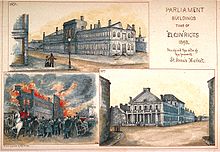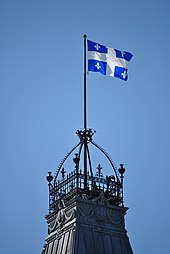Hôtel du Parlement du Quebec
| Assemblée nationale du Québec | |
|---|---|
|
Historic Place of Canada Lieu patrimonial du Canada |
|
| Recognized since | June 20, 1985 |
| ID | 9381 |
| place | Quebec |
| Coordinates | 46 ° 48 '31.5 " N , 71 ° 12' 51" W |
| Recognized by | Government of Quebec |
| Approved by | Loi sur les biens culturels |
| Entry Canadian List of Monuments | |
The Hôtel du Parlement du Québec is the seat of the National Assembly and the Vice-Governor of the Canadian province of Québec . It is located next to various other government buildings on the Colline parlementaire de Québec (Parliament Hill). The current structure is the fifth parliament building in the province of Québec.
history
From 1777 the British colonial government met in the chapel of the Bishop's Palace (French: Palais Episcopale ). The chapel was demolished in 1831 as part of the expansion work for the palace. With the establishment of the Province of Canada from the colonies of Upper and Lower Canada in 1840, the city of Québec lost its status as the capital of Lower Canada.
The seat of government changed several times: From 1841 to 1843 one met in a former hospital in Kingston ; From 1844, the Marché Sainte-Anne in Montreal served as the seat of parliament until the building burned down in 1849 as a result of political unrest; from 1849 Toronto and Québec alternated in the status of provincial capital. Work on the Bishop's Palace was not finished until 1850 due to the long vacancy. In 1852 it had to make way for a new building. This could be handed over to its purpose in 1859.
Queen Victoria had already decided in 1857 that Ottawa, on the border between the French and English-speaking areas, should become the capital of the emerging Dominion Canada. As a result of the constitutional law passed in 1867, the new state of Dominion of Canada was established . The previous province of Canada was again divided into its two parts Ontario and Québec; in addition there were the former colonies of New Brunswick and Nova Scotia .
Québec was once again the capital of the province of Québec and the parliament building from 1859 served as the seat of government until it burned down in 1883. The Parc Montmorency was created in its place after the current parliament building not far from the Citadel of Québec could finally be moved into in 1886.
architecture
The French-Canadian architect Eugène-Étienne Taché designed the building on a square floor plan in the style of the Second Empire , more precisely the Neo-Renaissance . Taché wanted the architecture to reflect the French heritage of Québec. The stone facade with the corner pavilions and the mansard roof refer to the Louvre or the Paris City Hall, which was built at the same time . The most striking feature is the 52 meter high tower. It is based on the belfry , a bell tower that is often found in town halls in northeastern France and Belgium. Fleurdelisé blows on it .
The coat of arms of Québec is emblazoned above the entrance with the French motto of the province: Je me souviens (Eng. "I remember"). The French lily motif and Queen Victoria's initials (VR for Victoria Regina ) can be found several times in the facade design and are reminiscent of the French and British history of Quebec.
In the roundabout in front of the parliament building there is a fountain, the Fontaine de Tourny .
Figure program
Like the Paris City Hall, the facade shows a wide range of figures. The 24 bronze sculptures show important people from Québec who contributed to the development of the province, the country or North America, so u. a .:
Jean Talon , New France's first director
Jacques Marquette , French Jesuit and explorer
Pierre Le Moyne d'Iberville , navigator, discoverer and founder of Louisiana
James Wolfe and Louis-Joseph de Montcalm , British and French generals, respectively; both fell in the battle of the Plains of Abraham
Guy Carleton , British general and Governor of Québec
James Bruce, 8th Earl of Elgin , Governor General of Canada
Robert Baldwin , Canadian Prime Minister and Reformer
Web links
Individual evidence
- ↑ http://www.assnat.qc.ca/en/visiteurs/parlement/parlement-1792.html
- ↑ http://www.ameriquefrancaise.org/en/article-%20538/The_Parliament_Building_of_Quebec:_A_Place_of_Memory.html
- ↑ http://www.telegraphe.com/sites/hotel_du_parlement/indexen.html
- ↑ http://www.ameriquefrancaise.org/en/article538/The_Parliament_Building_of_Quebec:_A_Place_of_Memory.html









